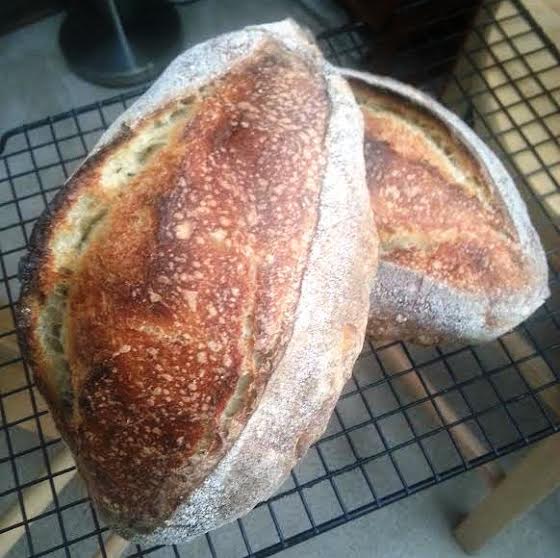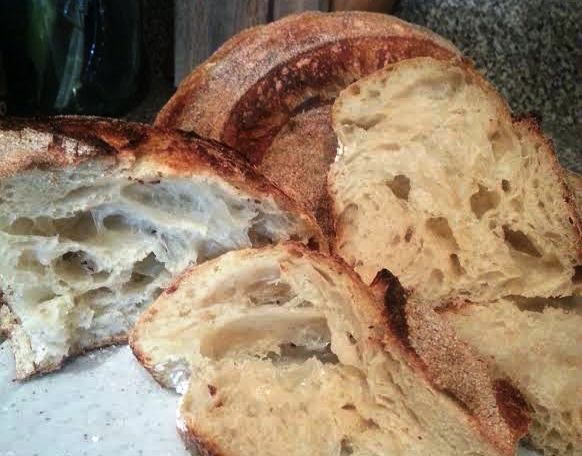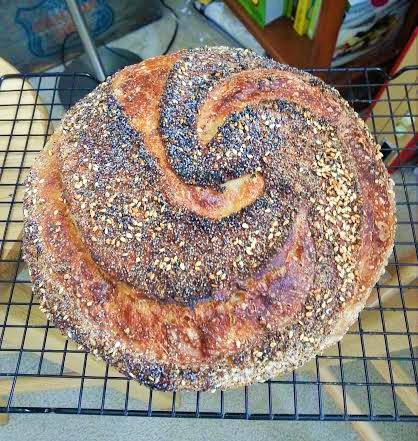
Finding the Levain % Sweet Spot (Formula Included!)

One of the most intriguing questions in my (admittedly short!) sourdough adventure thus far has been: How do I create a loaf that I can consistently proof in the refrigerator and bake straight from that cold environment, without it under or over-proofing? While the length of bulk fermentation is important in this calculus, it’s not the only part.
The following is the formula I've developed for one large loaf that is created specifically for a long proof in the refrigerator. The instructions are for a boule, but it could easily be shaped as a batard. Roughly 20% levain (by total weight, 40% by baker's percentage) seems to be my sweet spot for a long, cold-proofed loaf that can be baked straight from the fridge (i.e., proofs fully in the fridge at about 45 degrees F, but doesn’t over-proof!). I’ve baked this formula five times with great results...it can be modified to include more mix-ins, and even a significant percentage of whole grains.
The 78% hydration, long autolyse, chill during bulk fermentation, and long, cold proof yield a custardy, open crumb! The long autolyse also contributes to gluten formation, which make the final dough much easier to handle.
Ingredients:
200 g active 100% hydration white starter (however you want to create that levain)
400 g all-purpose flour (I love King Arthur)
290 g cool water
11 g (sea) salt
15 g sugar
5 g malt powder
Method:
1) Mix together flour and cool water, and set aside to autolyse at room temperature for anywhere from 6-12 hours. Make sure to mix the water and flour very well before this long autolyse; don't be afraid to really mash the dough down with a wet hand. You don't want any dry bits lingering, because they will be difficult to incorporate later. If you mix it well, it will be such smooth sailing when you mix in the levain, I promise!
2) Combine autolysed flour and water with the starter, salt, sugar, and malt powder. Squeeze the dough through your fingers to fully combine for the first two minutes or so, then stretch and fold for 2-3 minutes more.
3) Fold the dough every 30 minutes for the next 2 hours. When I stretch-and-fold, I like to give it as many turns as I feel the dough “needs.” To perform a fold, I reach under the dough and pull it over itself, rotating 90 degrees every time. At every 30-minute interval, I stop when the whole mass of dough begins to pull up out of the container. This is anywhere between 4 and 20 folds (that is, between 1 and 5 full stretch-and-fold turns).
4) Allow the dough to rest at room temperature between 2 and 4 hours, or until 70-80% increased in size. I realize that this is a bit more increase than is called for in some formulas, but it is my preference in this case!
5) Place the container of dough in the refrigerator for at least one hour, and up to 6 hours.*
6) Remove the container from the refrigerator. Sprinkle flour over the top of the dough and spread it. Loosen the dough from the sides of the container, allowing the flour to fall around the edges of the dough. This will create a nice floured gluten cloak at the bottom of your dough.
7) Pour the dough onto a work surface so that the floured surface is on the bottom. Pull the edges of the dough towards the middle to form a very loose boule -- this is the pre-shape. Rest for ten minutes.
8) After ten minutes, pull the edges towards the center and pick the ball up, twisting in your hand to create tension. Form a tight boule, however you’re most comfortable doing that.
9) Place the boule seam-side up in a floured banneton or brotform of some kind, and cover in plastic.
10) Allow it to rest at room temperature for 30 minutes.
11) Place in the refrigerator to proof for at least 8 hours, and up to 22 hours. The longer it proofs in the refrigerator, the more open and gelated the crumb will become.
12) Remove the banneton/brotform and release it onto a piece of parchment paper.
13) Score the boule, and bake at 475 F for 20 minutes with steam, then 20-25 minutes without steam.
*Alternatively, you could place the dough in the refrigerator directly after the two hours of stretch-and-fold, and then remove it later to sit at room temperature until increased 70-80%. Either way works great; I do stand by having a chill on the dough at some point during bulk fermentation.
Some loaves for which I've used this formula:
The Basic Formula (As Torpedoes and Boules):






80% Whole Wheat with Toasted Seeds and Cranberries:


Brown Ale and Spent Grain Torpedoes:


Everything Bagel Seasoning-Topped (Crowd Favorite!):

Thanks to all for your wonderful photos, formulas, and advice. TFL has just been the greatest resource as I navigate my first year of baking!
--Hannah


Comments
method very well. They all look perfect! Following you formula every loaf would over proof here in AZ. 15% levain max - no bulk ferment and 12 hour retard works for me - but I don't want to bake cold right out of the fridge - I want a 2 hour warm up on the counter. .My fridge is 36-38 F. It takes a while to figure it out but once you do you can get fine results like yours. Love the scoring and the batard shaping too. Well done and
Happy baking
Hannah: You have done it again. I love that swirl pattern. I will have to try it on my next boule. All of your scoring and crumb are outstanding. There is no way that you have been baking for only a year...not possible! You should see my first year bakes. Yours are highly professional! Thanks for sharing the formula, I will have to try it. Congratulations on these bakes. Very impressive and please keep them coming. Best, Phyllis
Awesome baking Hannah. It's hard to believe you have only been doing this for 1 year. Your loaves look very professional and your artistic scoring is just beautiful.
I almost always do a bulk retarding of the dough in the refrigerator instead of the shaped dough. This way works best for me, but obviously your method is working great for you. Thanks for sharing.
Regards,
Ian
Lovely breads. Now for that formula. Now ditch that sugar as your autolyse and the added malt are better solutions to natural sweetness. Seriously great looking breads
Josh
The tough love is important, Josh. I think the sugar is a holdover from when I didn't have malt and wanted that hint of sweetness/fermentation boost...then folks liked the result...BUT, you've inspired me to break the habit!
This formula is very different from the Sourdough bâtard w/ 80% hydration you had posted earlier. I have made that one a couple of weeks ago and just got it going again today (doubling the recipe this time). It produced a wonderful loaf! :) It's so easy because of the super-long proofing and retardation periods, very easily adjustable to a busy schedule.
With this new one (BEAUTIFUL loaves!), you increased the levain by a lot and thus reduced the timings. What end result do you prefer? Did you change it around because it works better for your schedule?
You are such a talent!
chouette22, thank you for your comment!
First, I just have to say that I get a little thrill whenever someone mentions that they used a formula I shared. Being a long home baker can be a little tough, and it's amazing to know that others in different parts of the country (or world!) are able to produce good loaves in ways I've found useful.
As to your excellent question: Truth be told, I am constantly experimenting with a range of methods, levain %, flours, and mix-in ingredients. I have been loving this 40% levain (by baker's percentage) formula, just because I like being able to work with the long cold proof sometimes.
But even as I type this response, I actually have two loaves proofing at room temperature, having been retarded for 48 hours during bulk fermentation. This time, I used 25% levain, by baker's percentage. I plan to use the freezer trick for 30 minutes at the end of the room temp proof before baking.
And tomorrow morning, I will bake another loaf, in which I used 10% levain and retarded for 72 hours! I'll proof that one at room temperature too.
I just can't settle on one way of doing it, and I think that's probably okay at my novice stage. I do absolutely love the way that TFL gives me the chance both to record and to share the formulas that I've found useful. And my arbitrary decision is to only post formulas I've baked from with success at least five times.
Please, always feel free to ask questions. It's in responding to all of you that I learn the most!
Well, you are turning into a master baker, a really inspired one too, who experiments and develops new formulae and rhythms with an instinctive feeling of what works (I don't think you are making any duds anymore, right?).
Since you are baking so often, you have such a good opportunity to compare the results from small (or big) change to small change. I make bread only about once a week/10 days and then I just want something that comes out of the oven as perfectly as I can make it.
Just curious: do you work in a creative field professionally too?
...both for honing techniques and for developing formulas.
I really do find as many excuses as possible to bake. I give a lot of bread away, take a lot to work, and most recently started accepting small commission requests!
I actually have a background in public policy and education; I taught history for awhile and still work in a school setting. Bread baking provides a great (and often kind of meditative) contrast to my other work!